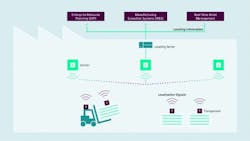Digital twin's missing piece: Real-time location
While plants and factories have long used deterministic communication networks to gather sensor data and close the loop on manufacturing processes, the real-time location of assets, tools, people and in-process inventory is often uncertain.
Indeed, as production process themselves have become smarter and more digital, knowing what and who are where and when has become an increasingly critical puzzle piece needed to fully model a plant’s complete production environment—and to optimize efficiency, visibility and worker safety, too.
Control recently caught up with Siemens’ Nicole Lauther, business development lead for the company’s new SIMATIC RTLS (for real-time locating system) to discuss the growing need for such systems across industry and how they can help to optimize today’s increasingly digital enterprises.
Business Development Lead, Simatic RTLS, Siemens USA
Control: How can a manufacturer or other industrial company benefit from a real-time locating system (RTLS)? What are the typical use cases, and what kinds of problems can they help to solve?Lauther: Industry is being challenged to be more flexible, to respond more quickly to changing market conditions and consumers’ demands for increasingly customized products. Industry also faces increasingly strict compliance requirements, such as traceability of raw material inputs and processing history. Companies need to know that their manufacturing processes and supporting logistics are flexible, fully documented and as efficient as possible—all while not increasing costs. Employee safety, too, is a critical concern.
For discrete manufacturing processes, real-time location tracking of in-process inventory provides detailed information on production progress, laying a foundation for precise documentation, traceability and intelligent process control. Tools and other mobile assets also can be localized to within inches and flexible geo-fencing can ensure locating and tracking in designated storage areas or work zones, for instance. Production steps can be automatically documented to ensure optimal work processes and assets can be localized in real time, eliminating time-consuming searches and providing up-to-date status information.
The logistics use cases also are varied and compelling. Within a plant, an RTLS can provide location and availability of forklift drivers or automatic guided vehicles (AGVs). And on the shipping dock, it can help to optimize fleet management, documenting arrival and departure times as well as providing access control.
People tracking, too, helps provide for improved workplace safety. Knowing where one’s employees are at all times facilitates efficient manpower planning, and ensures that all workers are accounted for in the event of an emergency.
Control: Other tracking solutions available from Siemens and other providers are based on RFID tags or barcodes. Can you describe how SIMATIC RTLS works, and what differentiates it from these solutions?
Lauther: The SIMATIC RTLS relies on mobile transponders with fixed anchors and gateways that together use high accuracy ultra-wide-band (UWB) radio signals to triangulate the location of the transponders at any given moment (see figure). Industrial identification technologies such as RFID and code-readers, on the other hand, are limited to tracking an object when it passes a certain read point.
Both types of technologies can complement the other. Let’s say you have smaller parts that you need to track; this can be done with RFID or a machine-readable code. Those parts might move through production on or in a carrier (bin, tote or box) that is localized with RTLS. Information from both systems can be tied together in the overlaying control/management system.
Siemens' real-time location system uses a combination of mobile transponders (T) together with stationary anchors (A) and gateways (G) to communicate real-time location information to other plant information and automation systems.
Control: How do real-time location systems such as the SIMATIC RTLS help to set the stage for continued innovation toward the Industry 4.0 model of the digital enterprise?
Lauther: The digital enterprise promises to change continuous-flow production. Advanced manufacturing technologies with built-in intelligence are enabling the emergence of smart factories that are dynamically self-organizing. This means that in the factory of the future, customer orders will draw their specific production recipes and instructions directly into their own manufacturing execution. In turn, machines will be largely self-directed by those orders. Logistics chains will automatically compile themselves in logical sequences.
Self-organizing production models will in turn require greater automation. This will likely include free-roaming collaborative robots and other mobile production assets that need real-time awareness of their own locations as well as that of other pieces of equipment and workers. In addition, self-organizing production models will have to be supported by innovative logistics and material flow concepts that eliminate costly search-and-assignment processes, such as managing a fleet of AGVs that must move in-process inventory among stationary production cells.
What’s needed to realize self-organizing production models is the automatic, real-time synchronization of processes in the physical domain with their virtual counterparts in the digital world: an end-to-end digital twin that spans receipt of raw material to shipment of finished good.
And because many of these assets are in motion at any point in time, the digital production twin needs to be able to answer the question of “What’s where and when?” at any given time, as well as for personnel, “Who is where and when?”
Siemens SIMATIC RTLS solutions can complete the production digital twin picture by providing dynamic location data in real time for all physical objects and personnel, whether at rest or in motion.



